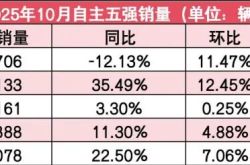Global AI Top 100 List Unveiled: Tech Titans Clash, China's "Corps" Emerges as a Surprise Contender
![]() 09/04 2025
09/04 2025
![]() 505
505

By Dao Ge
The highly anticipated AI list serves as a prism, illuminating the latest landscape of the global consumer AI market.
Recently, the fifth edition of the "Global AI Top 100 Application List (AI 100)" was released by Andreessen Horowitz (a16z), a leading venture capital firm in Silicon Valley. This biennial list not only evaluates which AI applications are truly captivating global users but also sheds light on the industry's ups and downs and future trends.
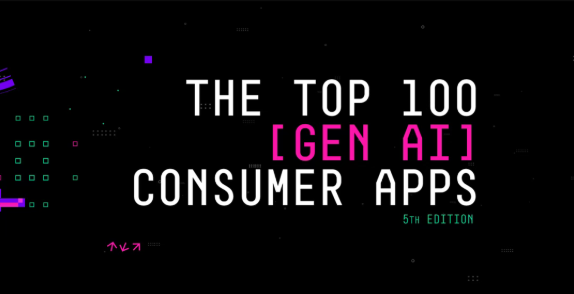
a16z's list ranks companies not by revenue but by "usage"—monthly unique visits to websites and monthly active users of mobile apps—which best reflects users' genuine choices.
According to "AI 100 Insights," the list clearly indicates that the AI market's frenetic pace is settling, the ecosystem is stabilizing, and it's becoming increasingly challenging for new entrants to break through. Tech giants, exemplified by Google, are striking back with unprecedented force, while a formidable "Chinese force" is taking a dual approach, not only fortifying barriers in the local market but also demonstrating astonishing global dominance, especially in mobile applications.
01 The Receding Tide, Market Stabilization, and New Battlegrounds for Titans
a16z's report begins by noting that the "Wild West" era of AI consumer applications may have ended, signaled by a decrease in "new faces."
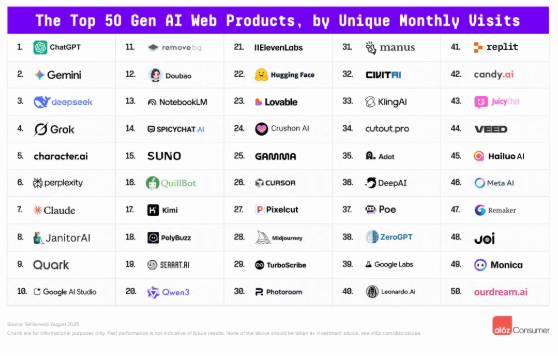
Web Top 50 List
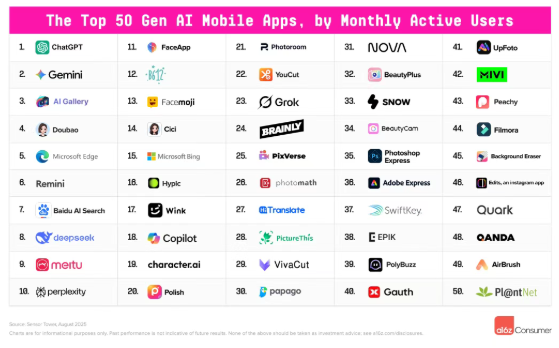
Mobile Top 50 List
Compared to 17 new applications entering the list in March 2025, this edition of the Web list features only 11 new entrants. The mobile side sees a slightly higher turnover rate with 14 new applications. a16z's analysis suggests this is partly due to app stores cracking down on "ChatGPT clones," paving the way for truly original mobile applications to thrive.
In this stabilized market landscape, competition among titans is intensifying and becoming more focused. ChatGPT from OpenAI, with its first-mover advantage, still holds the global top spot, but its quest for a worthy rival is being challenged.
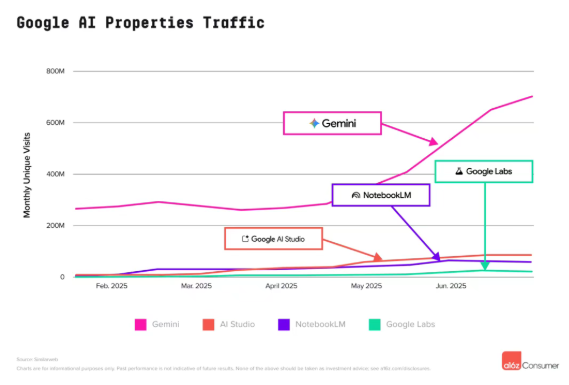
Google is catching up with a series of rapid "combination punches." In this edition, Google's AI products are ranked as independent entities for the first time, with four products making it into the Web top 50. Google's general AI assistant Gemini stands out, ranking second on the Web side, occupying about 12% of ChatGPT's traffic; on the mobile side, the gap is even narrower, with its monthly active users nearing half of ChatGPT's. Gemini's home-field advantage in the Android ecosystem is evident, with nearly 90% of its mobile users coming from Android, compared to about 60% for ChatGPT.
Beyond Gemini, which targets the general public, Google's product matrix showcases its deep layout in the AI field. AI Studio, an AI model testing ground for developers, debuted at 10th on the list. NotebookLM, a research and learning tool, ranked 13th, while Google Labs, integrating numerous experimental applications like the cutting-edge video model Veo 3, ranked 39th.
"AI 100 Insights" believes this "multi-product, decentralized warfare" strategy enables Google to cover diverse user groups from ordinary consumers to researchers and developers, building a robust AI ecosystem.
On the other side of the battlefield, Grok, launched by Elon Musk's X AI company, has shown "rocket-like" growth. With no independent mobile application at the end of 2024, Grok now ranks fourth on the Web side and 23rd on the mobile side, with monthly active users exceeding 20 million.
a16z's data shows that, particularly after the launch of the more powerful Grok 4 model and the AI companion avatar feature in July 2025, its mobile user base surged by nearly 40%. This remarkable growth is partly due to Musk's relentless promotion on the X platform and partly demonstrates the immense potential unleashed by deeply integrating AI into the social ecosystem.
In contrast, social giant Meta's AI journey has been rocky. Its Meta AI ranks only 46th on the Web side and fails to make the mobile top 50. a16z's analysis suggests that since its launch in late May this year, Meta AI's growth has been relatively slow, especially after a privacy issue in June where user posts were publicly shared without consent, significantly impacting its user growth.
02 Local Fortification and Global Expansion of the Chinese Corps
Notably, the collective rise of Chinese AI companies on this edition of the list has become the most striking highlight.
"AI 100 Insights" believes their unique approach can be summarized as "two-front warfare": one front deeply rooted in the local market, the other sailing overseas to expand globally.
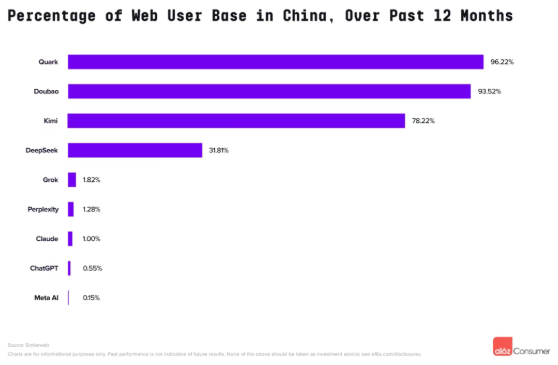
Chinese local AI applications have gained significant development space in the mainland. The report points out that Alibaba's Quark, ByteDance's Doubao, and Dark Side of the Moon's Kimi have entered the Web top 20, with over 75% of their traffic coming from China.
Among them, Quark performed the best, ranking 9th on the Web side and 47th on the mobile side. Doubao ranked 12th on the Web side and 4th on the mobile side. Kimi achieved 17th place on the Web side with its unique advantage in long-text processing.
The success of these three companies clearly reveals the key elements for success in the Chinese market—a vast user base, a deep understanding of local user needs, and a natural "moat" formed under specific policy environments.
If local market success can be partly attributed to "home-field advantage," then Chinese companies' performance in the global mobile application market is even more compelling evidence of their global competitiveness in technology and products.
The report emphasizes that among the top 50 mobile applications, as many as 22 are launched by Chinese developers. Within this "overseas" contingent, tool-type applications, especially in image and video editing, stand out.
Meitu, a company from Xiamen, has five applications on the list simultaneously, including Photo & Video Editor, BeautyPlus, BeautyCam, Wink, and Airbrush, forming an "image beautification matrix." Similarly, ByteDance's Hypic, a photo and video editing tool for overseas users, and another AI assistant Cici, are also on the list.
Besides image tools, DeepSeek, which once stirred up waves in overseas markets, and video generation models like Hailuo and Kling have also successfully made it onto the Web list. These products often possess strong technical capabilities but show distinct paths from domestic products in terms of business models and user growth.
a16z's analysts believe that part of the reason Chinese video models can lead globally is that China has a vast pool of AI research talent and differences in intellectual property regulations, which may allow them to train on more diverse data.
"AI 100 Insights" believes this phenomenon of "blooming inside the wall but fragrant outside" reveals another side of China's AI industry. A group of companies with core technologies is finding growth opportunities in overseas niche markets in a more flexible and globalized manner, bypassing the fierce "hundred-model war" in China. Their products often have solid technology, focused functions, and successfully adapt to the needs and aesthetics of global users.
03 Who Are the Future "AI Unicorns"?
At the end of the list, a16z also selected the "All-Star" companies in the AI industry. The reason for their selection is straightforward: 14 companies have consistently ranked among the top 50 in all five editions of the list, earning them the title of "All-Stars."
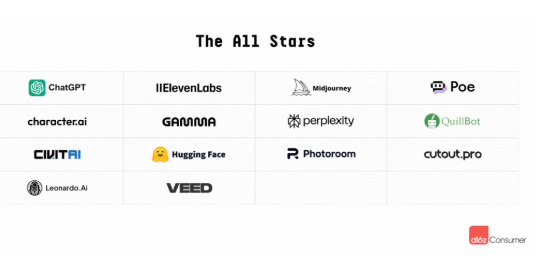
These companies represent a broad spectrum of consumer AI applications, such as assistance (ChatGPT, Perplexity, Poe), companionship (Character AI), image generation (Midjourney, Leonardo), image and video editing (Veed, Cutout), voice generation (Eleven Labs), productivity tools (Photoroom, Gamma, Quillbot), and model hosting (Civitai, HuggingFace).
a16z's latest list is like a detailed navigation chart, marking that after initial explosive growth, the global consumer AI market is entering broader but also more complex waters.
A new and increasingly clear industry order is emerging: platform-level giants led by OpenAI and Google are building their own powerful and comprehensive ecosystems, and the dimensions of competition have risen from single products to all-round confrontations involving models, platforms, applications, and distribution channels.
Meanwhile, the rise of Chinese AI forces is undoubtedly the most eye-catching trend in this new landscape. Whether they are local giants serving the huge domestic market or application developers expanding overseas, they have demonstrated strong technical capabilities and market adaptability, becoming an indispensable pole in the global AI landscape.
The list also reveals unlimited possibilities for the future. Whether it's the astonishing potential unleashed by deeply integrating AI with social networks, like Grok, or the quiet rise of "Vibe Coding" (an AI programming paradigm that quickly generates applications through natural language descriptions), they all indicate that the integration of AI with existing application scenarios will continue to spawn new product forms and business models.
"AI 100 Insights" believes that for AI entrepreneurs, the message conveyed by the list is complex and profound. On one hand, market stabilization means the dissipation of traffic dividends, making head-to-head competition with giants increasingly difficult; on the other hand, there are still a plethora of unmet needs and vast innovative spaces in vertical fields, niche scenarios, and new interactive experiences.
As observed in a16z's report, only 5 of the 14 "All-Star" companies have their own foundational models, and most successful applications are still built on third-party or open-source models. This shows that in the AI era, having a great idea and excellent product execution is just as important as having a powerful foundational model.
The tide has turned, and new sea routes are being explored. For all those part of this AI transformation wave, understanding this navigation chart and the new order that is forming may be the first step towards the future.
*The featured image is generated by AI



